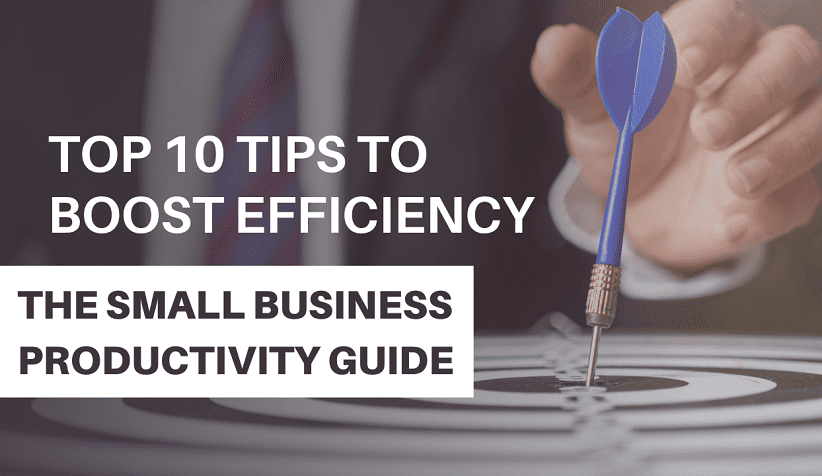Top 10 Tips to Boost Efficiency – The Small Business Productivity Guide
Boost Efficiency – With employees working remotely or in hybrid setups, adapting to new business needs is crucial. Maximizing productivity ensures success, even with a lean team. Here are ten strategies to boost efficiency and output in any business setting.
How to Maximize Small Business Productivity
-
Use Communication and Collaboration Tools
Email alone isn’t enough for remote teams. Invest in tools like Slack, Asana, Trello, Google Drive, or Microsoft OneDrive to streamline communication, track progress, and enhance collaboration.
-
Ensure Employee Accountability
Track work hours and productivity using time-tracking software. Conduct performance reviews to identify high achievers and support struggling employees. Replace consistently under-performing staff if necessary.
-
Set Clear and Prioritized Goals
Define realistic goals and break them into smaller, actionable tasks. Setting clear deadlines and expectations helps employees stay focused and motivated.
-
Create a Positive Work Environment
Employee happiness boosts productivity. Offer perks like remote-friendly incentives (e.g., meal vouchers for virtual lunches) and foster a supportive culture.
-
Minimize Time-Wasting Activities
Encourage employees to reduce distractions like phone notifications and unnecessary meetings. Use project management tools to streamline updates and keep meetings focused.
-
Automate Repetitive Tasks
Use automation tools to handle repetitive tasks like data entry, invoicing, and customer follow-ups. This allows employees to focus on more critical tasks.
-
Organize Workflows Efficiently
Prioritize tasks based on urgency and importance. Regularly reassess workflows to eliminate inefficiencies and optimize workload distribution.
-
Outsource Menial Tasks
Delegate non-essential tasks like payroll or administrative duties to freelancers or external agencies. This frees up employees to focus on core business functions.
-
Integrate Apps and Systems
Use integrated software solutions to avoid inefficiencies. Platforms like Salesforce or Zapier help sync multiple tools, reducing manual data transfer.
-
Learn from Your Team
Ask employees for feedback on workflow improvements. Use anonymous surveys if necessary to gather honest insights and enhance productivity while maintaining a balanced workload.
Boosting productivity doesn’t require massive changes—small, strategic improvements can make a significant impact. By leveraging technology, optimizing workflows, and fostering a positive work culture, businesses can enhance efficiency and employee satisfaction.
FAQ – Frequently Asked Questions
- What does boosting efficiency mean?
Boosting efficiency means completing tasks faster, using fewer resources, and achieving better results. It’s about working smarter, not harder, to maximize output and minimize waste.
- Why is efficiency important in the workplace?
Efficiency saves time, reduces costs, and improves overall productivity. It also helps businesses stay competitive, meet customer expectations faster, and create a better work-life balance for employees.
- What are the best ways to improve efficiency at work?
Some top ways to improve efficiency include:
- Setting clear goals and priorities
- Automating repetitive tasks
- Using productivity tools
- Delegating tasks wisely
- Reducing distractions
- How can technology help boost efficiency?
Technology streamlines processes by automating routine tasks, improving communication, managing projects more effectively, and providing real-time data for quicker decision-making.
- What role does time management play in efficiency?
Good time management ensures that tasks are completed in a structured, timely manner without last-minute rushes. Prioritizing, planning, and setting deadlines are key to staying efficient.
- How can teams work more efficiently together?
Teams can boost efficiency by:
- Communicating openly and regularly
- Clearly defining roles and responsibilities
- Using project management tools
- Encouraging collaboration and knowledge sharing
- Holding effective, focused meetings
- What are some common barriers to efficiency?
Common barriers include:
- Poor communication
- Lack of clear goals
- Overcomplicated processes
- Frequent interruptions
- Low employee motivation
- How can leaders encourage an efficiency-focused culture?
Leaders can set the tone by:
- Modeling efficient work habits
- Recognizing and rewarding efficient behavior
- Providing training and resources
- Continuously reviewing and refining processes
- Can boosting efficiency impact employee satisfaction?
Yes! When work processes are smooth and effective, employees feel less stressed, more accomplished, and more motivated. A well-organized environment improves job satisfaction and retention.
- How often should businesses review their efficiency strategies?
Businesses should review efficiency strategies regularly — at least quarterly. Regular reviews help identify what’s working, what’s not, and what can be improved as new challenges or technologies emerge.
Thanks for visiting Physics Wala


